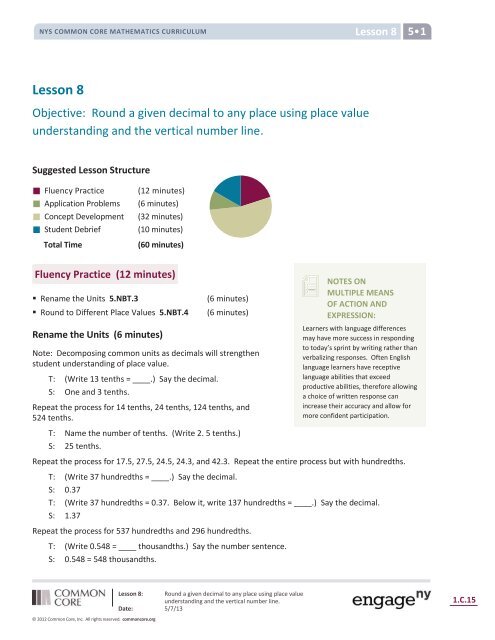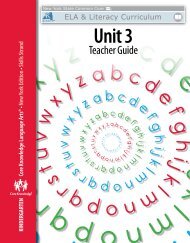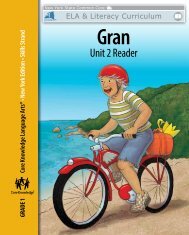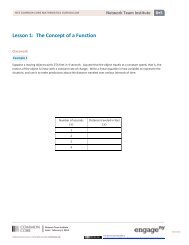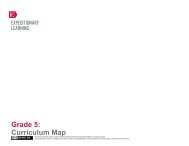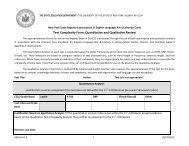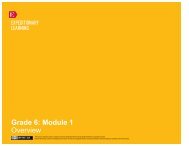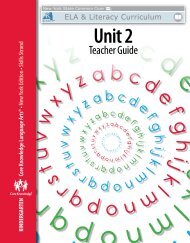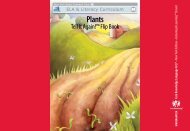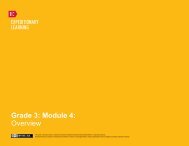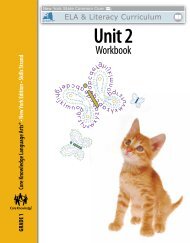Lesson 8 - EngageNY
Lesson 8 - EngageNY
Lesson 8 - EngageNY
Create successful ePaper yourself
Turn your PDF publications into a flip-book with our unique Google optimized e-Paper software.
NYS COMMON CORE MATHEMATICS CURRICULUM <strong>Lesson</strong> 8 5•1<br />
<strong>Lesson</strong> 8<br />
Objective: Round a given decimal to any place using place value<br />
understanding and the vertical number line.<br />
Suggested <strong>Lesson</strong> Structure<br />
•Fluency Practice<br />
•Application Problems<br />
•Concept Development<br />
•Student Debrief<br />
Total Time<br />
(12 minutes)<br />
(6 minutes)<br />
(32 minutes)<br />
(10 minutes)<br />
(60 minutes)<br />
Fluency Practice (12 minutes)<br />
• Rename the Units 5.NBT.3<br />
• Round to Different Place Values 5.NBT.4<br />
Rename the Units (6 minutes)<br />
(6 minutes)<br />
(6 minutes)<br />
Note: Decomposing common units as decimals will strengthen<br />
student understanding of place value.<br />
T: (Write 13 tenths = ____.) Say the decimal.<br />
S: One and 3 tenths.<br />
Repeat the process for 14 tenths, 24 tenths, 124 tenths, and<br />
524 tenths.<br />
T: Name the number of tenths. (Write 2. 5 tenths.)<br />
S: 25 tenths.<br />
NOTES ON<br />
MULTIPLE MEANS<br />
OF ACTION AND<br />
EXPRESSION:<br />
Learners with language differences<br />
may have more success in responding<br />
to today’s sprint by writing rather than<br />
verbalizing responses. Often English<br />
language learners have receptive<br />
language abilities that exceed<br />
productive abilities, therefore allowing<br />
a choice of written response can<br />
increase their accuracy and allow for<br />
more confident participation.<br />
Repeat the process for 17.5, 27.5, 24.5, 24.3, and 42.3. Repeat the entire process but with hundredths.<br />
T: (Write 37 hundredths = ____.) Say the decimal.<br />
S: 0.37<br />
T: (Write 37 hundredths = 0.37. Below it, write 137 hundredths = ____.) Say the decimal.<br />
S: 1.37<br />
Repeat the process for 537 hundredths and 296 hundredths.<br />
T: (Write 0.548 = ____ thousandths.) Say the number sentence.<br />
S: 0.548 = 548 thousandths.<br />
© 2012 Common Core, Inc. All rights reserved. commoncore.org<br />
<strong>Lesson</strong> 8: Round a given decimal to any place using place value<br />
understanding and the vertical number line.<br />
Date: 5/7/13<br />
1.C.15
NYS COMMON CORE MATHEMATICS CURRICULUM <strong>Lesson</strong> 8 5•1<br />
T: (Write 0.548 = 548 thousandths. Below it, write 1.548 = ____ thousandths.) Say the number<br />
sentence.<br />
S: 1.548 = 1548 thousandths.<br />
Repeat the process for 2.548 and 7.352.<br />
Round to Different Place Values (6 minutes)<br />
Materials: (S) Personal white boards<br />
Note: Reviewing this skill introduced in <strong>Lesson</strong> 7 will help students<br />
work towards mastery of rounding decimal numbers to different<br />
place values.<br />
Although the approximation sign (≈) is used in Grade 4, a quick<br />
review of its meaning may be in order.<br />
T: (Project 8.735.) Say the number.<br />
S: 8 and 735 thousandths.<br />
T: Draw a vertical number line on your boards with 2<br />
endpoints and a midpoint.<br />
T: Between what two ones is 8.735?<br />
S: 8 ones and 9 ones.<br />
T: What’s the midpoint for 8 and 9?<br />
S: 8.5<br />
T: Fill in your endpoints and midpoint.<br />
T: 8.5 is the same as how many tenths?<br />
S: 85 tenths.<br />
T: How many tenths are in 8.735?<br />
S: 87 tenths.<br />
NOTES ON<br />
MULTIPLE MEANS<br />
OF ENGAGEMENT:<br />
Turn and talk is a strategy intended to<br />
broaden active student participation by<br />
offering opportunity for all to speak<br />
during a lesson. Spend time in the<br />
beginning of the school year helping<br />
students understand what turn and<br />
talk looks like and sounds like by<br />
demonstrating with a student for the<br />
whole class. Modeling knee-to-knee,<br />
eye-to-eye body posture and active<br />
listening expectations (Can I restate my<br />
partner’s ideas in my own words?)<br />
make for successful implementation of<br />
this powerful strategy.<br />
T: (Write 8.735 ≈ _______.) Show 8.735 on your number line and write the number sentence.<br />
S: (Students write 8.735 between 8.5 and 9 on the number line and write 8.735 ≈ 9.)<br />
Repeat the process for the tenths place and hundredths place. Follow the same process and procedure for<br />
7.458.<br />
Application Problem (6 minutes)<br />
Organic, whole-wheat flour sells in bags weighing 2.915 kilograms. How much flour is this rounded to the<br />
nearest tenth? How much flour is this rounded to the nearest one? What is the difference of the two<br />
answers? Use a place value chart and number line to explain your thinking.<br />
© 2012 Common Core, Inc. All rights reserved. commoncore.org<br />
<strong>Lesson</strong> 8: Round a given decimal to any place using place value<br />
understanding and the vertical number line.<br />
Date: 5/7/13<br />
1.C.16
NYS COMMON CORE MATHEMATICS CURRICULUM <strong>Lesson</strong> 8 5•1<br />
Concept Development (32 minutes)<br />
Materials: (S) Personal place value boards<br />
Problem 1<br />
Round 49.67 to the nearest ten.<br />
T: Turn and talk to your partner about the different ways 49.67<br />
could be decomposed using place value disks. Show the<br />
decomposition that you think will be most helpful in<br />
rounding to the nearest ten.<br />
T: Which one of these decompositions did you decide was the<br />
most helpful?<br />
S: The decomposition with more tens is most helpful, because<br />
it helps me identify the two rounding choices: 4 tens or 5<br />
tens.<br />
5 tens or 50<br />
45.67<br />
4 tens or 40<br />
4 tens 9 ones 6 tenths 7 hundredths<br />
49 ones 6 tenths 7 hundredths<br />
496 tenths 7 hundredths<br />
T: Draw and label a number line and circle the rounded<br />
value. Explain your reasoning.<br />
Repeat this sequence with rounding 49.67 to the nearest ones, and then tenths.<br />
Problem 2<br />
Decompose 9.949 and round to the nearest tenth and hundredth.<br />
Show your work on a number line.<br />
9 ones 9 tenths 4 hundredths 9 thousandths<br />
100 tenths = 10<br />
9.949<br />
99 tenths 4 hundredths 9 thousandths<br />
994 hundredths 9 thousandths<br />
99 tenths = 9.9<br />
T: What decomposition of 9.949 best helps to round this<br />
number to the nearest tenth?<br />
S: The one using the most tenths to name the decimal fraction. I knew I would round to either 99<br />
tenths or 100 tenths. I looked at the hundredths. Nine hundredths is past the midpoint, so I<br />
rounded to the next tenth, 100 tenths. One hundred tenths is the same as 10.<br />
© 2012 Common Core, Inc. All rights reserved. commoncore.org<br />
<strong>Lesson</strong> 8: Round a given decimal to any place using place value<br />
understanding and the vertical number line.<br />
Date: 5/7/13<br />
1.C.17
NYS COMMON CORE MATHEMATICS CURRICULUM <strong>Lesson</strong> 8 5•1<br />
T: Which digit made no difference when you rounded to the nearest tenth? Explain your thinking.<br />
S: The thousandths, because the hundredths decided which direction to round. As long as I had 5<br />
hundredths, I was past the halfway point so I rounded to the next number.<br />
Repeat the process rounding to the nearest hundredth.<br />
Problem 3<br />
A decimal number has 1 digit to the right of the decimal point. If we round this number to the nearest whole<br />
number, the result is 27. What are the maximum and minimum possible values of these two numbers? Use a<br />
number line to show your reasoning. Include the midpoint on the number line.<br />
T: (Draw a vertical number line with 3 points.)<br />
T: What do we know about the unknown number?<br />
S: It has a number in the tenths place, but nothing else past the decimal point. We know that is has<br />
been rounded to 27.<br />
T: (Write 27 at the bottom point on the number line and circle it.) Why did I place 27 as the lesser<br />
rounded value?<br />
S: We are looking for the largest number that will round down to 27. That number will be greater than<br />
27, but less than the midpoint between 27 and 28.<br />
T: What is the midpoint between 27 and 28?<br />
S: 27.5<br />
T: (Place 27.5 on the number line.)<br />
T: If we look at numbers that have exactly 1 digit to the right of the decimal point, what is the greatest<br />
one that will round down to 27?<br />
S: 27.4. If we go to 27.5, that would round up to 28.<br />
Repeat the same process to find the minimum value.<br />
To find maximum<br />
To find minimum<br />
28<br />
27<br />
27.4<br />
26.5<br />
27<br />
26<br />
27<br />
© 2012 Common Core, Inc. All rights reserved. commoncore.org<br />
<strong>Lesson</strong> 8: Round a given decimal to any place using place value<br />
understanding and the vertical number line.<br />
Date: 5/7/13<br />
1.C.18
NYS COMMON CORE MATHEMATICS CURRICULUM <strong>Lesson</strong> 8 5•1<br />
Encourage further discussion with the following:<br />
What if our number had exactly 2 digits to the right of the decimal point? Could I find a number larger than<br />
27.4 that would still round down to 27? (Various answers could be expected: 27.41, 27.49, etc.). What is the<br />
largest possible value it could have? (27.49.)<br />
A similar discussion can take place in finding the minimum when students discover that 26.5 rounds up to 27.<br />
Lead students to discover that something different happens here. Can we find a number less than 26.5 with<br />
exactly 2 digits to the right of the decimal point that would still round up? (No, nothing smaller than 26.50.)<br />
Problem Set (10 minutes)<br />
Students should do their personal best to complete the problem set within the allotted 10 minutes. For some<br />
classes, it may be appropriate to modify the assignment by specifying which problems they work on first.<br />
Some problems do not specify a method for solving. Students solve these problems using the RDW approach<br />
used for Application Problems.<br />
On this Problem Set, we suggest all students begin with Problems 1 and 3 and possibly leave Problem 2 to the<br />
end if they still have time.<br />
Before circulating while students work, review the debrief questions relevant to the problem set so that you<br />
can better guide students to a deeper understanding of a skill with the lesson’s objective.<br />
Student Debrief (10 minutes)<br />
<strong>Lesson</strong> Objective: Round a given decimal to any place<br />
using place value understanding and the vertical<br />
number line.<br />
The Student Debrief is intended to invite reflection and<br />
active processing of the total lesson experience.<br />
Invite students to review their solutions for the Problem<br />
Set. They should check work by comparing answers<br />
with a partner before going over answers as a class.<br />
Look for misconceptions or misunderstandings that can<br />
be addressed in the Debrief. Guide students in a<br />
conversation to debrief the Problem Set and process<br />
the lesson. You may choose to use any combination of<br />
the questions below to lead the discussion.<br />
• Compare our approach to rounding today and<br />
yesterday. How are they alike? How are they<br />
different? (Students will likely offer many<br />
accurate responses. However, lead the<br />
discussion toward the notion of our only<br />
choosing specific decompositions to round in<br />
today’s lesson as opposed to naming every<br />
© 2012 Common Core, Inc. All rights reserved. commoncore.org<br />
<strong>Lesson</strong> 8: Round a given decimal to any place using place value<br />
understanding and the vertical number line.<br />
Date: 5/7/13<br />
1.C.19
NYS COMMON CORE MATHEMATICS CURRICULUM <strong>Lesson</strong> 8 5•1<br />
decomposition in yesterday’s lesson. Also<br />
explore which units (place values) are worthy of<br />
attention and which are not when rounding to<br />
a specific place value. Are there patterns to<br />
these choices?)<br />
• Once a number rounds up at one place value,<br />
does it follow then that every place value will<br />
round up? Why or why not? (Encourage<br />
students to reference their problem sets as<br />
evidence of their reasoning. Problem 1(b)<br />
provides an example of differing unit choices<br />
resulting in differences in rounding up and down.)<br />
• How does the place value chart help organize<br />
your thinking when rounding?<br />
• Finding the maximum and minimum values poses<br />
a significant increase in cognitive load and an<br />
opportunity to build excitement! Make time to<br />
deeply discuss ways of reasoning about these<br />
tasks, as they are sure to be many and varied.<br />
Consider a discussion of Problem 3 that mirrors<br />
the one in the lesson: What if our number had<br />
exactly three digits to the right of the decimal?<br />
Can we find a value larger than 13.74 that would round down to 13.7? (13.749) What about 4<br />
places or 5 places to the right of the decimal? (13.7499, 13.74999) Encourage students to generalize<br />
that we can get infinitely close to 13.5 with a decimal that has an infinite number of 9’s yet that<br />
decimal will still round down to 13.7. We can find points on the number line as close as we like, and<br />
yet they will not be equal to 13.75. Follow that with the discovery that this is not true for our<br />
minimum value. There is nothing smaller than 13.750 that will round up to 13.8. Math journals offer<br />
a venue for students to continue to explore maximum and minimum tasks beyond today’s lesson.<br />
Exit Ticket (3 minutes)<br />
After the Student Debrief, instruct students to complete the Exit Ticket. A review of their work will help you<br />
assess the students’ understanding of the concepts that were presented in the lesson today and plan more<br />
effectively for future lessons. You may read the questions aloud to the students.<br />
© 2012 Common Core, Inc. All rights reserved. commoncore.org<br />
<strong>Lesson</strong> 8: Round a given decimal to any place using place value<br />
understanding and the vertical number line.<br />
Date: 5/7/13<br />
1.C.20
NYS COMMON CORE MATHEMATICS CURRICULUM <strong>Lesson</strong> 8 Problem Set 5•1<br />
Name<br />
Date<br />
1. Write the decomposition that helps you, and then round to the given place value. Draw number lines to<br />
explain your thinking. Circle the rounded value on each number line.<br />
a. Round 32.697 to nearest tenth, hundredth, and whole number.<br />
b. Round 141.999 to nearest tenth, hundredth, ten, and hundred.<br />
2. A root beer factory produces 132,554 cases in 100 days. About how many cases does the factory produce<br />
in 1 day? Round your answer to the nearest tenth of a case. Show your thinking on the number line.<br />
© 2012 Common Core, Inc. All rights reserved. commoncore.org<br />
<strong>Lesson</strong> 8: Round a given decimal to any place using place value<br />
understanding and the vertical number line.<br />
Date: 5/7/13<br />
1.C.21
NYS COMMON CORE MATHEMATICS CURRICULUM <strong>Lesson</strong> 8 Problem Set 5•1<br />
3. A decimal number has two digits to the right of its decimal point. If we round it to the nearest tenth, the<br />
result is 13.7.<br />
a. What is the maximum possible value of this number? Use words and the number line to explain your<br />
reasoning. Include the midpoint on your number line.<br />
13.8<br />
13.7<br />
b. What is the minimum possible value of this decimal? Use words and the number line to explain your<br />
reasoning. Include the midpoint on your number line.<br />
© 2012 Common Core, Inc. All rights reserved. commoncore.org<br />
<strong>Lesson</strong> 8: Round a given decimal to any place using place value<br />
understanding and the vertical number line.<br />
Date: 5/7/13<br />
1.C.22
NYS COMMON CORE MATHEMATICS CURRICULUM <strong>Lesson</strong> 8 Exit Ticket 5•1<br />
Name<br />
Date<br />
1. Round the quantity to the given place value. Draw number lines to explain your thinking. Circle the<br />
rounded value on the number line.<br />
a. 13.989 to nearest tenth b. 382.993 to nearest hundredth<br />
© 2012 Common Core, Inc. All rights reserved. commoncore.org<br />
<strong>Lesson</strong> 8: Round a given decimal to any place using place value<br />
understanding and the vertical number line.<br />
Date: 5/7/13<br />
1.C.23
NYS COMMON CORE MATHEMATICS CURRICULUM <strong>Lesson</strong> 8 Homework 5•1<br />
Name<br />
Date<br />
1. Round the quantity to the given place value. Draw number lines to explain your thinking. Circle the<br />
rounded value on the number line.<br />
a. 43.586 to nearest tenth, hundredth, and whole number<br />
b. 243.875 to nearest tenth, hundredth, ten, and hundred<br />
2. A trip from New York City to Seattle is 2,852.1 miles. A family wants to make the drive in 10 days, driving<br />
the same number of miles each day. About how many miles will they drive each day? Round you answer<br />
to the nearest tenth of a mile.<br />
© 2012 Common Core, Inc. All rights reserved. commoncore.org<br />
<strong>Lesson</strong> 8: Round a given decimal to any place using place value<br />
understanding and the vertical number line.<br />
Date: 5/7/13<br />
1.C.24
NYS COMMON CORE MATHEMATICS CURRICULUM <strong>Lesson</strong> 8 Homework 5•1<br />
3. A decimal number has two digits to the right of its decimal point. If we round it to the nearest tenth, the<br />
result is 18.6.<br />
a. What is the maximum possible value of this decimal? Use words and the number line to explain your<br />
reasoning.<br />
18.7 (1870 hundredths)<br />
18.6<br />
b. What is the minimum possible value of this decimal? Use words, numbers and pictures to explain<br />
your reasoning.<br />
18.6<br />
18.5<br />
© 2012 Common Core, Inc. All rights reserved. commoncore.org<br />
<strong>Lesson</strong> 8: Round a given decimal to any place using place value<br />
understanding and the vertical number line.<br />
Date: 5/7/13<br />
1.C.25


